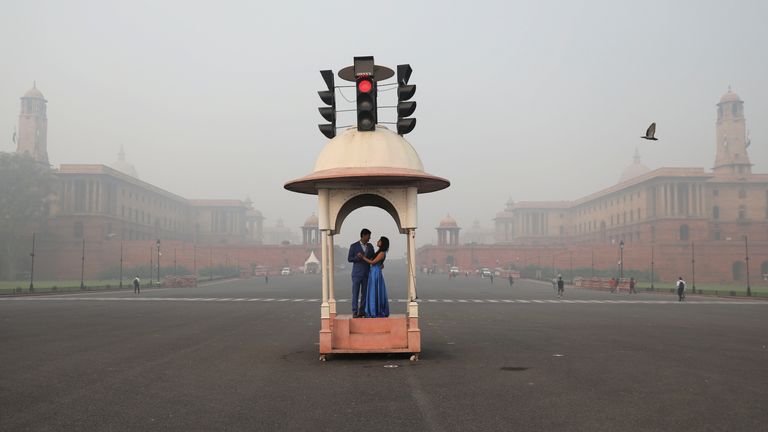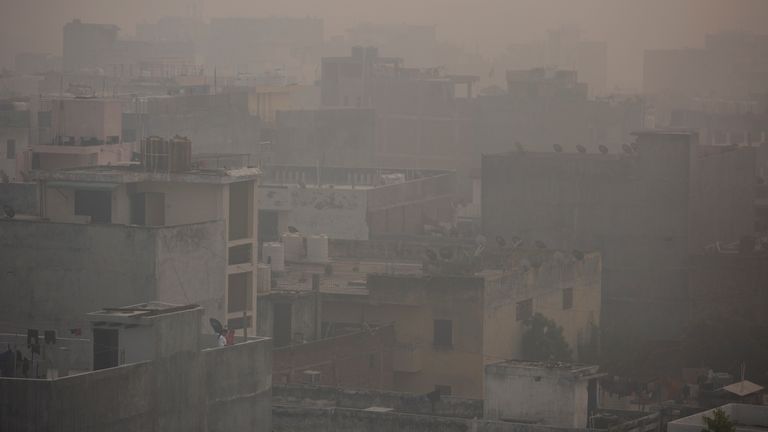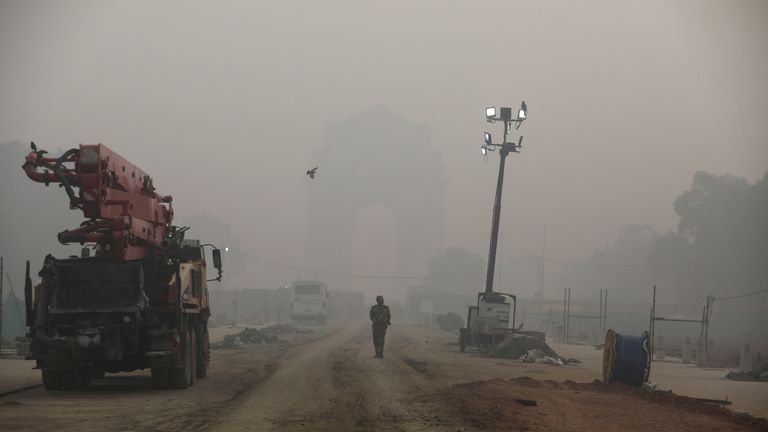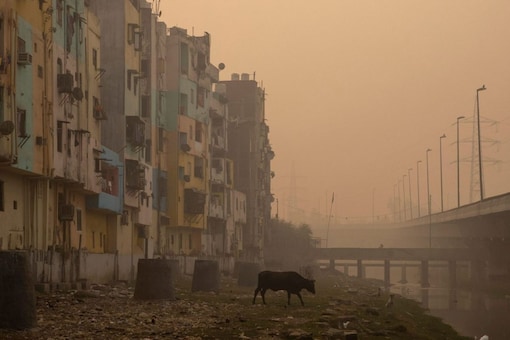UPDATED
New Delhi wakes up to blanket of toxic smog and worst pollution all year after defying firework ban
In India, toxic air kills more than a million people annually but the government has been accused of not doing enough to curb pollution - instead prioritising economic growth.
Megan Baynes
News reporter @megbaynes
Friday 5 November 2021
 Image:Residents of New Delhi woke up to the most polluted air of the year so far
Image:Residents of New Delhi woke up to the most polluted air of the year so far
The morning after Diwali celebrations residents of New Delhi woke up to a blanket of toxic smog, breathing in the most polluted air of the year so far.
The city has the worst air quality of all the world's capitals, but Friday's reading was the highest of 2021, as people paid the price for defying the fireworks ban.
Sponsored link
The Air Quality Index (AQI) surged to 451 out of 500 - the maximum recorded this year.

The AQI measures the concentration of poisonous particulate matter PM2.5 in a cubic metre of air.
In Delhi, the PM2.5 reading on Friday averaged 706 micrograms. The World Health Organisation deems anything above an annual average of five micrograms unsafe.
By comparison, London measured 50 PM2.5 on the AQI on Friday morning.
In India, toxic air kills more than a million people annually.
"The firecracker ban didn't seem to be successful in Delhi, which led to hazardous pollution levels adding on top of existing perennial sources," Sunil Dahiya, analyst at the Centre for Research on Energy and Clean Air (CREA) said.
The government imposes a ban on fireworks every year, but these are rarely enforced.
Stubble fires - where farmers in Delhi's neighbouring states of Punjab and Haryana burn fields to prepare for the next crop - also account for 35% of New Delhi's PM2.5 levels.
Ambrish Mithal, a doctor at the Max HealthCare hospital in New Delhi, vented his frustration on Twitter, and said: "It's terrible for those with allergies and asthma. We will continue to squabble over reasons and are doomed to suffer."

Delhi wakes to post-Diwali smogIn India, toxic air kills more than a million people annually but the government has been accused of not doing enough to curb pollution - instead prioritising economic growth.
Megan Baynes
News reporter @megbaynes
Friday 5 November 2021
 Image:Residents of New Delhi woke up to the most polluted air of the year so far
Image:Residents of New Delhi woke up to the most polluted air of the year so farThe morning after Diwali celebrations residents of New Delhi woke up to a blanket of toxic smog, breathing in the most polluted air of the year so far.
The city has the worst air quality of all the world's capitals, but Friday's reading was the highest of 2021, as people paid the price for defying the fireworks ban.
Sponsored link
The Air Quality Index (AQI) surged to 451 out of 500 - the maximum recorded this year.

Image:Morning haze and smog envelops the skyline after Diwali fireworks were let off despite a ban
It indicates "severe" conditions that will affect healthy people and seriously impact those with pre-existing conditions.
It indicates "severe" conditions that will affect healthy people and seriously impact those with pre-existing conditions.
The AQI measures the concentration of poisonous particulate matter PM2.5 in a cubic metre of air.
In Delhi, the PM2.5 reading on Friday averaged 706 micrograms. The World Health Organisation deems anything above an annual average of five micrograms unsafe.
By comparison, London measured 50 PM2.5 on the AQI on Friday morning.
In India, toxic air kills more than a million people annually.
"The firecracker ban didn't seem to be successful in Delhi, which led to hazardous pollution levels adding on top of existing perennial sources," Sunil Dahiya, analyst at the Centre for Research on Energy and Clean Air (CREA) said.
The government imposes a ban on fireworks every year, but these are rarely enforced.
Stubble fires - where farmers in Delhi's neighbouring states of Punjab and Haryana burn fields to prepare for the next crop - also account for 35% of New Delhi's PM2.5 levels.
Ambrish Mithal, a doctor at the Max HealthCare hospital in New Delhi, vented his frustration on Twitter, and said: "It's terrible for those with allergies and asthma. We will continue to squabble over reasons and are doomed to suffer."

An Indian paramilitary soldier walks near India Gate which is shrouded in smog
The government has been accused of not doing enough to curb pollution, instead prioritising economic growth.
On Monday, Prime Minister Narendra Modi told the COP26 climate summit in Glasgow that India would achieve net zero carbon emissions by 2070 - two decades after the date set by other countries.
In October, intermittent rain and winds led to to a rare drop in pollution, with residents breathing the cleanest air in four years before conditions quickly deteriorated.
Pollution levels often surge in winter months, as lower temperatures and a drop in wind speed traps pollutants in the air for longer.
The government has been accused of not doing enough to curb pollution, instead prioritising economic growth.
On Monday, Prime Minister Narendra Modi told the COP26 climate summit in Glasgow that India would achieve net zero carbon emissions by 2070 - two decades after the date set by other countries.
In October, intermittent rain and winds led to to a rare drop in pollution, with residents breathing the cleanest air in four years before conditions quickly deteriorated.
Pollution levels often surge in winter months, as lower temperatures and a drop in wind speed traps pollutants in the air for longer.
India's Pledge at COP26 on Point. But Need of the Hour is Focus on Rapid Relief from Toxic Air

A day ahead of Diwali 2021, the average air quality in the national capital had slid into the 'very poor' category. (File picture)
India has in the recent past taken several quick measures to prevent air pollution, including the replacement of solid fuels with gas for cooking.
NEWS18.COM
LAST UPDATED:NOVEMBER 05, 2021
Environment experts have lauded India for doing more than most countries, including China, and reducing emissions. According to them, the country’s pledge at COP26 to achieve net zero carbon emissions by 2070 is “real climate action". The promises made by Prime Minister Narendra Modi to tackle climate change at the 26th international climate conference in Glasgow included achieving carbon neutrality by 2070.
While the experts said that by making the pledge, India has put the ball in the court of developed nations to fulfil the promise $1 trillion of climate finance, the move does not bring relief from the immediate problem of toxic air that the people, especially those in the national capital, are having to breath in.
Also Read: Data From 5 Years Shows AQI Shot up to Toxic Levels Each Diwali, Delhiites Learnt No Lessons
The Air Quality Index deteriorates to a new low each year around the months of October-December as stubble burning from neighbouring states intensifies and people violate norms and burst firecrackers to celebrate the festival of Diwali. This year, too, despite a Supreme Court order, several appeals by the Delhi government and other efforts in place to keep a check on bursting of firecrackers during Diwali, several areas in the city reported violations as people burst crackers all through Thursday.
On Friday morning, Delhiites woke up to a thick blanket of smog and a worrying AQI of 617. People from several parts of the city and its suburbs complained of itchy throat and watery eyes. The city’s overall air quality index was 451 at 8 am and entered the “severe" category, according to the Ministry of Earth Sciences’ air quality forecast agency System of Air Quality and Weather Forecasting And Research (SAFAR). At around 3am, the air quality at Janpath in Delhi was in ‘hazardous’ category with PM2.5 at 655.07.

Modi, The Economist said in a piece on Friday, highlighted at Glasgow that while poor countries bear a mere fraction of the blame for creating the world’s climate mess, some, such as India, have done better at keeping environmental commitments than many rich countries.
As per the report, India, with 18% of the world’s population, is estimated to have caused just 3% of accumulated CO2 emissions. Yet even as Indian leaders repeatedly—and sometimes justifiably—take the moral high ground on climate change’s long-term challenges, their people continue to suffer and die from its immediate, home-grown causes, it says.
The Economist further points out that the problem is not faced by Delhi alone. “In winter the Himalayas trap the combined exhaust of the 600m people who populate the sprawling Indo-Gangetic Plain. From diesel pumps for irrigation to cremation pyres and from coal-fired power plants to gas-guzzling suvs, the smoke combines in a toxic stew that can hang for weeks in the season’s typically windless conditions. Big provincial cities such as Lucknow and Patna are just as sooty as Delhi. So are many rural areas,” it says.
Climate change activist and director general of Centre for Science and Environment Sunita Narain has said that India has laid out its roadmap, and targets of non-fossil fuel, renewable energy (RE) and reduction of carbon intensity are all pathways to get one billion tonnes carbon emission reduction by 2030.
“RE target of 50 per cent, non-fossil fuel 500 GW; carbon intensity of 45 per cent are all pathways to get to 1 billion tonnes carbon emission reduction by 2030. India has laid out its roadmap; this is more than OECD and certainly what China has done. India enhanced NDC (Nationally Determined Contribution) is a challenge to the world to step up," she said in a tweet.
Along with this ready roadmap, India has taken several other quick measures to prevent air pollution, including the replacement of solid fuels with gas for cooking.
It has also ramped up its solar and wind power capacity and, backed by Modi, tightened the vehicle-emissions rules. With a goal to cut pollution in 122 cities by up to 30% in the next five years, the central government in 2019 also launched a National Clean Air Programme.

A day ahead of Diwali 2021, the average air quality in the national capital had slid into the 'very poor' category. (File picture)
India has in the recent past taken several quick measures to prevent air pollution, including the replacement of solid fuels with gas for cooking.
NEWS18.COM
LAST UPDATED:NOVEMBER 05, 2021
Environment experts have lauded India for doing more than most countries, including China, and reducing emissions. According to them, the country’s pledge at COP26 to achieve net zero carbon emissions by 2070 is “real climate action". The promises made by Prime Minister Narendra Modi to tackle climate change at the 26th international climate conference in Glasgow included achieving carbon neutrality by 2070.
While the experts said that by making the pledge, India has put the ball in the court of developed nations to fulfil the promise $1 trillion of climate finance, the move does not bring relief from the immediate problem of toxic air that the people, especially those in the national capital, are having to breath in.
Also Read: Data From 5 Years Shows AQI Shot up to Toxic Levels Each Diwali, Delhiites Learnt No Lessons
The Air Quality Index deteriorates to a new low each year around the months of October-December as stubble burning from neighbouring states intensifies and people violate norms and burst firecrackers to celebrate the festival of Diwali. This year, too, despite a Supreme Court order, several appeals by the Delhi government and other efforts in place to keep a check on bursting of firecrackers during Diwali, several areas in the city reported violations as people burst crackers all through Thursday.
On Friday morning, Delhiites woke up to a thick blanket of smog and a worrying AQI of 617. People from several parts of the city and its suburbs complained of itchy throat and watery eyes. The city’s overall air quality index was 451 at 8 am and entered the “severe" category, according to the Ministry of Earth Sciences’ air quality forecast agency System of Air Quality and Weather Forecasting And Research (SAFAR). At around 3am, the air quality at Janpath in Delhi was in ‘hazardous’ category with PM2.5 at 655.07.

Modi, The Economist said in a piece on Friday, highlighted at Glasgow that while poor countries bear a mere fraction of the blame for creating the world’s climate mess, some, such as India, have done better at keeping environmental commitments than many rich countries.
As per the report, India, with 18% of the world’s population, is estimated to have caused just 3% of accumulated CO2 emissions. Yet even as Indian leaders repeatedly—and sometimes justifiably—take the moral high ground on climate change’s long-term challenges, their people continue to suffer and die from its immediate, home-grown causes, it says.
The Economist further points out that the problem is not faced by Delhi alone. “In winter the Himalayas trap the combined exhaust of the 600m people who populate the sprawling Indo-Gangetic Plain. From diesel pumps for irrigation to cremation pyres and from coal-fired power plants to gas-guzzling suvs, the smoke combines in a toxic stew that can hang for weeks in the season’s typically windless conditions. Big provincial cities such as Lucknow and Patna are just as sooty as Delhi. So are many rural areas,” it says.
Climate change activist and director general of Centre for Science and Environment Sunita Narain has said that India has laid out its roadmap, and targets of non-fossil fuel, renewable energy (RE) and reduction of carbon intensity are all pathways to get one billion tonnes carbon emission reduction by 2030.
“RE target of 50 per cent, non-fossil fuel 500 GW; carbon intensity of 45 per cent are all pathways to get to 1 billion tonnes carbon emission reduction by 2030. India has laid out its roadmap; this is more than OECD and certainly what China has done. India enhanced NDC (Nationally Determined Contribution) is a challenge to the world to step up," she said in a tweet.
Along with this ready roadmap, India has taken several other quick measures to prevent air pollution, including the replacement of solid fuels with gas for cooking.
It has also ramped up its solar and wind power capacity and, backed by Modi, tightened the vehicle-emissions rules. With a goal to cut pollution in 122 cities by up to 30% in the next five years, the central government in 2019 also launched a National Clean Air Programme.

At various hotspots, levels of harmful PM 2.5 particles topped 400 on average on the air quality index
Prakash SINGH AFP
Issued on: 05/11/2021 -
New Delhi (AFP) – New Delhi woke up to a thick blanket of toxic smog on Friday after an overnight barrage of firecrackers for the Hindu festival of Diwali in the Indian megacity, despite a ban on selling them.
At various hotspots, levels of harmful PM 2.5 particles topped 400 on average on the air quality index.
The figure is more than 15 times higher than the safe daily limit set by the World Health Organization.
India's top court has banned the sale of firecrackers in Delhi and the local government urged people to celebrate Diwali without them.
But many of the capital's roughly 20 million residents still got hold of them, setting them off all over the city until the early hours of the morning for the annual Festival of Lights.

People make their way along a street amid smoggy conditions in New Delhi
Issued on: 05/11/2021 -
New Delhi (AFP) – New Delhi woke up to a thick blanket of toxic smog on Friday after an overnight barrage of firecrackers for the Hindu festival of Diwali in the Indian megacity, despite a ban on selling them.
At various hotspots, levels of harmful PM 2.5 particles topped 400 on average on the air quality index.
The figure is more than 15 times higher than the safe daily limit set by the World Health Organization.
India's top court has banned the sale of firecrackers in Delhi and the local government urged people to celebrate Diwali without them.
But many of the capital's roughly 20 million residents still got hold of them, setting them off all over the city until the early hours of the morning for the annual Festival of Lights.

People make their way along a street amid smoggy conditions in New Delhi
Prakash SINGH AFP
Firecracker smoke combines with industrial and vehicle emissions and farm fires to create a putrid grey-yellow soup that envelops Delhi and other Indian cities in winter.
Sandeep, a Delhi resident, told AFP on Friday he did not think the government was doing enough to counter the pollution challenge.
"I think a great deal (more) needs to be done," he said while on a morning walk at Delhi's Lodhi Gardens.
A 2020 report by Swiss organisation IQAir found 22 of the world's 30 most polluted cities were in India, with Delhi ranked the most polluted capital globally.
The same year, the Lancet said 1.67 million deaths were attributable to air pollution in India in 2019, including almost 17,500 in the capital.
© 2021 AFP
Firecracker smoke combines with industrial and vehicle emissions and farm fires to create a putrid grey-yellow soup that envelops Delhi and other Indian cities in winter.
Sandeep, a Delhi resident, told AFP on Friday he did not think the government was doing enough to counter the pollution challenge.
"I think a great deal (more) needs to be done," he said while on a morning walk at Delhi's Lodhi Gardens.
A 2020 report by Swiss organisation IQAir found 22 of the world's 30 most polluted cities were in India, with Delhi ranked the most polluted capital globally.
The same year, the Lancet said 1.67 million deaths were attributable to air pollution in India in 2019, including almost 17,500 in the capital.
© 2021 AFP
Beijing shuts roads, playgrounds amid heavy smog after coal spike
Issued on: 05/11/2021 -

Schools in Beijing -- which will host the Winter Olympics in February -- were ordered to stop physical education classes and outdoor activities due to the smog
Issued on: 05/11/2021 -

Schools in Beijing -- which will host the Winter Olympics in February -- were ordered to stop physical education classes and outdoor activities due to the smog
JADE GAO AFP
Beijing (AFP) – Highways and school playgrounds in Beijing were closed Friday due to heavy pollution, as China ramps up coal production and faces scrutiny of its environmental record at make-or-break international climate talks
World leaders have gathered in Scotland this week for COP26 negotiations billed as one of the last chances to avert catastrophic climate change, though Chinese President Xi Jinping made a written address instead of attending in person.
China -- the world's largest emitter of the greenhouse gases responsible for climate change -- has ramped up coal output after supply chains in recent months were roiled by an energy crunch owing to strict emissions targets and record prices for the fossil fuel.
A thick haze of smog blanketed swathes of northern China on Friday, with visibility in some areas reduced to less than 200 metres (yards), according to the country's weather forecaster.
Authorities in Beijing blamed the pollution on "unfavourable weather conditions and regional pollution spread" as schools in the capital -- which will host the Winter Olympics in February -- were ordered to stop physical education classes and outdoor activities.
Stretches of highways to major cities including Shanghai, Tianjin and Harbin were closed Friday due to poor visibility.
Pollutants detected Friday morning by a monitoring station at the US embassy in Beijing reached levels defined as "very unhealthy" for the general population.
Beijing (AFP) – Highways and school playgrounds in Beijing were closed Friday due to heavy pollution, as China ramps up coal production and faces scrutiny of its environmental record at make-or-break international climate talks
World leaders have gathered in Scotland this week for COP26 negotiations billed as one of the last chances to avert catastrophic climate change, though Chinese President Xi Jinping made a written address instead of attending in person.
China -- the world's largest emitter of the greenhouse gases responsible for climate change -- has ramped up coal output after supply chains in recent months were roiled by an energy crunch owing to strict emissions targets and record prices for the fossil fuel.
A thick haze of smog blanketed swathes of northern China on Friday, with visibility in some areas reduced to less than 200 metres (yards), according to the country's weather forecaster.
Authorities in Beijing blamed the pollution on "unfavourable weather conditions and regional pollution spread" as schools in the capital -- which will host the Winter Olympics in February -- were ordered to stop physical education classes and outdoor activities.
Stretches of highways to major cities including Shanghai, Tianjin and Harbin were closed Friday due to poor visibility.
Pollutants detected Friday morning by a monitoring station at the US embassy in Beijing reached levels defined as "very unhealthy" for the general population.
JADE GAO AFP
Levels of small particulate matter, or PM 2.5, which penetrate deep into human lungs and cause respiratory illnesses hovered around 220 -- far above the WHO recommended limit of 15.
The smog is likely to persist until at least Saturday evening, according to city officials.
China said earlier this week it had increased daily coal production by more than one million tonnes to ease an energy shortage that had forced factories to close in recent months.
Rapid industrialisation has made China no stranger to air pollution, although severe smog episodes have become less frequent in recent years as authorities have increasingly prioritised environmental protection.
Beijing has pledged to bring emissions of planet-heating carbon dioxide to a peak by 2030 and reduce them to net zero by 2060.
China hit back Wednesday at criticism by Joe Biden, saying "actions speak louder than words" after the US president accused Beijing of not showing leadership to combat climate change.
China generates about 60 percent of its energy from burning coal.
© 2021 AFP
Levels of small particulate matter, or PM 2.5, which penetrate deep into human lungs and cause respiratory illnesses hovered around 220 -- far above the WHO recommended limit of 15.
The smog is likely to persist until at least Saturday evening, according to city officials.
China said earlier this week it had increased daily coal production by more than one million tonnes to ease an energy shortage that had forced factories to close in recent months.
Rapid industrialisation has made China no stranger to air pollution, although severe smog episodes have become less frequent in recent years as authorities have increasingly prioritised environmental protection.
Beijing has pledged to bring emissions of planet-heating carbon dioxide to a peak by 2030 and reduce them to net zero by 2060.
China hit back Wednesday at criticism by Joe Biden, saying "actions speak louder than words" after the US president accused Beijing of not showing leadership to combat climate change.
China generates about 60 percent of its energy from burning coal.
© 2021 AFP

No comments:
Post a Comment